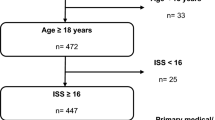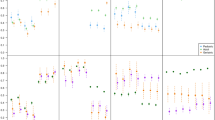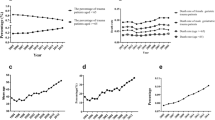Abstract
Introduction
Early physiological assessment of multiple injured patients is crucial for decision making and has relied on personal experience of trauma experts. We have developed a new visual analytics tool (Sankey diagram, Watson Trauma Health care tool) that includes known prognostic parameters for polytrauma patients to help guide assessment and treatment decisions for physicians involved in trauma care.
Methods
A prospectively collected trauma database of a single level I trauma center (3655 patients) was used. Inclusion criteria: age >16 years, an injury severity score (ISS) >16 and presence of a complete data set in the database. Data collected included admission values of patient age, injury scoring, shock classification, temperature, acid–base and hemostasis parameters. All of these parameters were collected daily as longitudinal parameters. Endpoints of the clinical course we considered were sepsis, SIRS and early in hospital mortality (<72 h). A proof of concept of the visualization was developed over a 2-year period in a cooperation between physicians and engineers. Statistically, the most predictive parameters were selected by binary logistic regression and ROC analysis.
Results
A dynamic interactive multilayer Sankey diagram, based on cohort similarities, was developed in a collaboration between the University Hospital of Zurich, Department of Trauma and IBM, from August 2017 until January 2018. It is a modular tool and allows any user to add a new patient, or work with an existing case. The visualization used the data-driven documents (D3) interactive visualization library to create a responsive graphic.
Conclusions
This application summarizes the experience of 3655 polytrauma patients and might serve as a guide for clinical decisions and educative purposes, as well as new scientific questions for the polytrauma patient.
Level of evidence
IV.



Similar content being viewed by others
References
Champion HR, Copes WS, Sacco WJ et al (1990) The major trauma outcome study: establishing national norms for trauma care. J Trauma 30(11):1356–1365
Sauaia A, Moore EE, Johnson JL et al (2014) Temporal trends of postinjury multiple-organ failure: still resource intensive, morbid, and lethal. J Trauma Acute Care Surg 76(3):582–592
Spahn DR, Bouillon B, Cerny V et al (2019) The European guideline on management of major bleeding and coagulopathy following trauma: fifth edition. Crit Care 23(1):98
Billeter A, Turina M, Seifert B et al (2009) Early serum procalcitonin, interleukin-6, and 24-hour lactate clearance: useful indicators of septic infections in severely traumatized patients. World J Surg 33(3):558–566. https://doi.org/10.1007/s00268-008-9896-y
Pape HC, Lefering R, Butcher N et al (2014) The definition of polytrauma revisted: an international consensus process and proposal of the new ‘Berlin definition’. J Trauma Acute Care Surg 77(5):780–786
Pape HC, Champion HR (2015) Patient assessment in polytrauma: current trends rely on multiple parameters to improve the prediction of complications and mortality. Injury 46(10):1875–1877
van Tienhoven AJ, van Beers CAJ, Siegert CEH (2019) Agreement between arterial and peripheral venous lactate levels in the ED: a systematic review. Am J Emerg Med 37(4):746–750
Sprengel K, Simmen H, Werner CM et al (2016) Resuscitation with polymeric plasma substitutes is permissive for systemic inflammatory response syndrome and sepsis in multiply injured patients: a retrospective cohort study. Eur J Med Res 21(1):39
Mitra B, Tullio F, Cameron PA et al (2012) Trauma patients with the ‘triad of death’. Emerg Med J 29:622–625
Kutcher ME, Howard BM, Sperry JL et al (2015) Evolving beyond the vicious triad: differential mediation of traumatic coagulopathy by injury, shock, and resuscitation. J Trauma Acute Care Surg 78(3):516–523
Tran A, Yates J, Lau A et al (2018) Permissive hypotension versus conventional resuscitation strategies in adult trauma patients with hemorrhagic shock: a systematic review and meta-analysis of randomized controlled trials. J Trauma Acute Care Surg 84(5):802–808
Scalea TM, DuBose J, Moore EE et al (2012) Western Trauma Association critical decisions in trauma: management of the mangled extremity. J Trauma Acute Care Surg 72(1):86–93
Undurraga Perl VJ, Leroux B, Cook MR et al (2016) Damage-control resuscitation and emergency laparotomy: findings from the PROPPR study. J Trauma Acute Care Surg 80(4):568–574
Pape HC, Rixen D, Morley J et al (2007) Impact of the method of initial stabilization for femoral shaft fractures in patients with multiple injuries at risk for complications (borderline patients). Ann Surg 246(3):491–499
Horst K, Andruszkow H, Weber CD et al (2017) Thoracic trauma now and then: a 10 year experience from 16,773 severely injured patients. PLoS ONE 12(10):e0186712
Sakellaris G, Blevrakis E, Petrakis I, Dimopoulou A, Dede O, Partalis N, Alegakis A, Seremeti C, Spanaki AM, Briassoulis G (2014) Acute coagulopathy in children with multiple trauma: a retrospective study. J Emerg Med 47:539–545
Wang HE, Callaway CW, Peitzman AB et al (2005) Admission hypothermia and outcome after major trauma. Crit Care Med 33:1296–1301
Pape HC, Giannoudis PV, Krettek C et al (2005) Timing of fixation of major fractures in blunt polytrauma: role of conventional indicators in clinical decision making. J Orthop Trauma 19:551–562
van Tienhoven AJ, van Beers CAJ, Siegert CEH (2019) Agreement between arterial and peripheral venous lactate levels in the ED: a systematic review. Am J Emerg Med 37:746–750
Ogura T, Nakamura Y, Nakano M et al (2014) Predicting the need for massive transfusion in trauma patients: the Traumatic Bleeding Severity Score. J Trauma Acute Care Surg 76(5):1243–1250
Ebadollahi S, Sun J, Gotz D et al (2010) Predicting patient’s trajectory of physiological data using temporal trends in similar patients: a system for near-term prognostics. AMIA Annu Symp Proc 2010:192–196
Sankey HR (1896) The thermal efficiency of steam-engines. MPICE 125:182–212
Fekete JD, van Wijk JJ, Stasko JT et al (2008) The value of information visualization. In: Kerren A, Stasko JT, Fekete JD, North C (eds) Information visualization. Lecture notes in computer science, vol 4950. Springer, Berlin, pp 1–18
Mathis B, Ma Y, Mancenido M et al (2019) Exploring the design space of Sankey diagrams for the food-energy-water nexus. IEEE Comput Graph Appl. https://doi.org/10.1109/MCG.2019.2927556
Platzer A, Polzin J, Rembart K et al (2018) BioSankey: visualization of microbial communities over time. J Integr Bioinform 15(4):20170063
Ahmed MN, Toor AS, O’Neil K et al (2017) Cognitive computing and the future of health care cognitive computing and the future of healthcare: the cognitive power of IBM Watson has the potential to transform global personalized medicine. IEEE Pulse 8(3):4–9
Shader RI (2016) Some reflections on IBM Watson and on women’s health. Clin Ther 38(1):1–2
Guo S, Lin C, Gotz D et al (2016) Understanding care plans of community acquired pneumonia based on Sankey diagram. In: Visual analytics in healthcare workshop. https://guoshunan.github.io/files/sankey.pdf. Accessed 2016
Moher D, Shamseer L, Clarke M et al (2015) Preferring reporting items for systematic review and meta-analysis protocols (PRISMA-P) 2015 statement. Syst Rev 4:1
Osler T, Baker SP, Long W (1997) A modification of the injury severity score that both improves accuracy and simplifies scoring. J Trauma 43(6):922–925
Dübendorfer C, Billeter AT, Seifert B et al (2013) Serial lactate and admission SOFA scores in trauma: an analysis of predictive value in 724 patients with and without traumatic brain injury. Eur J Trauma Emerg Surg 39(1):25–34
Mica L, Albrecht K, Keel M, Trentz O (2012) Independent predictors of early death of polytrauma patients: an analysis of 696 patients. J Trauma Treat 1:2–5
Dienstknecht T, Rixen D, Giannoudis P et al (2013) Do parameters used to clear noncritically injured polytrauma patients for extremity surgery predict complications? Clin Orthop Relat Res 471(9):2878–2884
Hildebrand F, Lefering R, Andruszkow H et al (2015) Development of a scoring system based on conventional parameters to assess polytrauma patients: poly trauma grading score (PTGS). Injury 46(Suppl 4):S93–S98
Ahmed MN, Toor AS, O’Neil K et al (2017) Cognitive computing and the future of health care cognitive computing and the future of healthcare: the cognitive power of IBM Watson has the potential to transform global personalized medicine. IEEE Pulse 8(3):4–9
Bostock M (2017) Angular java script network. Updated 07.09.2018. https://bost.ocks.org/mike/
Bootstrap: designed and built by @mdo and @fat. Version 4.1.3. Updated 24.07.2018. https://getbootstrap.com/
Bostock M (2017) Data driven documents. Version 5.7.0. Updated 24.08.2018. https://d3js.org/
Brohi K, Cohen MJ, Davenport RA (2007) Acute coagulopathy of trauma: mechanism, identification and effect. Curr Opin Crit Care 13:680–685
Kauvar DS, Lefering R, Wade CE (2006) Impact of hemorrhage on trauma outcome: an overview of epidemiology, clinical presentations, and therapeutic considerations. J Trauma 60(6 Suppl):S3–S11
Nathens AB, Jurkovich GJ, Cummings P et al (2000) The effect of organized systems of trauma care on motor vehicle crash mortality. JAMA 283(15):1990–1994
Halvachizadeh S, Pape HC (2019) Determining the patient at risk—are scoring systems helpful to develop individualized concepts for safe definitive fracture fixation and damage control techniques? Injury 50(7):1269–1271
Trentzsch H, Huber-Wagner S, Hildebrand F et al (2012) Hypothermia for prediction of death in severely injured blunt trauma patients. Shock 37:131–139
Border JR (1995) Death from severe trauma: open fractures to multiple organ dysfunction syndrome. J Trauma 39:12–22
Ogura T, Nakamura Y, Nakano M et al (2014) Predicting the need for massive transfusion in trauma patients: the Traumatic Bleeding Severity Score. J Trauma Acute Care Surg 76(5):1243–1250
Acknowledgements
Innovation Funding INOV00040; University Hospital Zurich; 8091 Zurich; Switzerland; 06/2017; Ladislav Mica.
Author information
Authors and Affiliations
Corresponding author
Ethics declarations
Conflict of interest
The authors declare no conflict of interest related to the submitted study.
Ethical approval
“Retrospektive Analysen in der Chirurgischen Intensivmedizin” Nr. St.V. 01-2008. Ladislav Mica.
Additional information
Publisher's Note
Springer Nature remains neutral with regard to jurisdictional claims in published maps and institutional affiliations.
Rights and permissions
About this article
Cite this article
Mica, L., Niggli, C., Bak, P. et al. Development of a Visual Analytics Tool for Polytrauma Patients: Proof of Concept for a New Assessment Tool Using a Multiple Layer Sankey Diagram in a Single-Center Database. World J Surg 44, 764–772 (2020). https://doi.org/10.1007/s00268-019-05267-6
Published:
Issue Date:
DOI: https://doi.org/10.1007/s00268-019-05267-6




